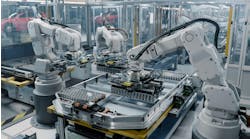Much has been said about the emergence of collaborative robots into the mainstream of manufacturing. Robots have been around for a very long time, but the development of robots that could operate in the same workspace as humans has truly taken the technology to the next level. Not too many years ago, the very thought that a robot could interact with humans in an intimate environment would have been the product of a storyboard artist making the next episodes of “The Jetsons.” Now it is becoming commonplace, and one would be hard-pressed to imagine an automated assembly line that didn’t at least consider the prospect of collaborative robots.
Coming out of this rapidly expanding technology, traditional automation providers have been scrambling to come up with ways to integrate collaborative robots into their product lines. Some of the larger players in the packaging-machinery business have been figuring out ways to use the close-proximity workhorses to complement or even replace their traditional machines for functions such as case-erecting, packing and case-sealing.
An interesting trend that has recently come to the surface is the use of collaborative robots to palletize, or unitize, products that had previously been stacked using manual labor. The typical machine or full-size robot versions of these take up a lot of real estate on the plant floor, and this made them inappropriate as a replacement operation.
Only those companies with the resources and appropriate space to plan and build new production lines could consider using the traditional end-of-line palletizers. There is an old saying that “necessity is the mother of invention,” and this could not be truer than when it comes to the implementation of collaborative robots. The very possibility that an automated device could occupy the very same workspace as a person and do as good of a job or better is too juicy of an opportunity to pass up.
One well-known conveyor company has taken up the challenge of integrating its products with a collaborative robot by taking the user interface for the robot and layering its own user interface on top of it. The base user interface of the robot was already easy to use, but the value-added interface changes the multi-tasking nature of the native interface and narrows it down to specifically address the use of the robot functions relative to the conveyor products that the robot will interact with.
Taking it further, the company has developed a workspace that allows the user to very easily adapt to various end-of-line packaging needs by moving the robot into a new workspace and, scanning a data matrix code attached to the standard conveyor offerings, quickly configure the robot to perform pre-planned routines.
The possibilities are practically endless, but, given the usual packaging methods of an end user, the conveyor vendor has been able to narrow down the possibilities to a manageable subset that is very attractive to the customer. This approach has enabled the vendor to launch installations all over the world that number in the hundreds in just a couple of years.
The value-added service is becoming more commonplace across multiple industries. Another long-term provider of conveyors has taken a different approach to value-added. Rather than embracing the collaborative robot by offering solutions that use the robot, this particular vendor has offered up a software module written in the operating system of a specific collaborative robot that allows the automation provider an easy way to integrate the conveyor product into a design that utilizes the collaborative robot.
This added value suggests two things. One, the particular collaborative robot is clearly headed for industry dominance as it would seem imprudent to spend the time and money to develop a software module for a robot that wasn’t going to be used by many. The other value to this offering is making it inherently easy for an automation company that might standardize on that same collaborative robot to have an easy method to add this particular conveyor product to the automation solution, since the code is already written.
These two very innovative approaches to value-added machinery manufacturing is an interesting twist in the conventional approach to control design. I can’t recall another example of two or more distinct automation providers publicly acknowledging the market presence of the other in such a direct manner in my 30 or so years of experience in the automation design business.
Traditionally, it has been the responsibility of an integrator to pull all the pieces of the puzzle together and perform the important task of making sure the various parts all fit together in a seamless fashion. For manufacturers to go to the trouble of not only acknowledging each other, but sharing enough information to provide complementary parts of the solution, shows a clear change in the direction of automation.
Collaboration isn’t limited to robots and conveyors. Other vendors are coming up with innovative ways to make it easier to integrate their particular products into another product’s design structure. This has been happening for a while but seems to be gaining speed of late.
Most of the major PLC or PAC manufacturers have a feature that allows for the inclusion of a profile or instruction—function block—that, when loaded in the PLC logic structure, allows the user to utilize a pre-programmed software interface to a specific add-on device or multiple instances of that device or family of devices. At the base of most devices is a data structure that contains the input and output bit, bytes and words that make up the interface to the outside world.
Earlier versions of this interface were called names such as electronic data sheets or general station description, but at their base they were a defined structure that contained a header that described the device, as well as defined the block size of the input and output words that contained the information that passed to and from the device over an industrial network protocol like CANbus, Profibus, Modbus, DeviceNet, ControlNet, Ethernet I/P and CompoBUS/S, to name a few.
These earlier versions were somewhat basic, in that they organized the transmission of blocks of data into input and output structures but left it up to the end user to review the documentation from the manufacturer of the device to determine the specific nature of the input and output blocks. The programmer would then have to assign descriptions to the bits, bytes and words to provide clarity when writing the software to interface with the device.
The progression toward an add-on profile or instruction or function block enabled the manufacturer, or a clever end user, to provide a block of code that automates the process of not only defining the device, but automatically assigns the descriptors to the bits and bytes to make it human-readable.
Newer versions of that same function-block format use structured text tags that further enhance the programmer’s ability to easily interface with the device by breaking down the memory blocks into structures specific to the data being exchanged.
Examples of the manufacturer-specific function block or add-on profiles include digital sensors and valves at the base level but can be of greater value when used for devices such as barcode scanners, variable-frequency and servo drives, linear actuators and a broad base of analog devices. The more recent IO-Link technology takes that base function further by transmitting not just the control-specific elements of devices, but includes diagnostic information about the device, such as temperature or operating parameters.
The latest innovation is to take an entire unit of operation, such as a code printer or even a case erector or, perhaps, a collaborative robot, and provide a manufacturer-developed add-on instruction—function block—that provides a completely programmed interface with all contained functions of the unit op.
Imagine the convenience of have block of code, written by the machine vendor, that contain all of the necessary functions of that unit op. All of the code has been pre-tested and verified by the manufacturer.
This latest trend in the industry is to provide an easy means for control designers to incorporate products from differing vendors into a design without having to get into the bits and bytes level of each device or unit op. At the risk of sounding like a cheesy presenter on a shopping network, “How easy is that?”
Collaboration isn’t just about the interaction between mankind and a machine. It is also about vendors taking away the mystery and making it easier for a design to come to fruition by providing collaborative elements that have a modular feel to them and make it practically impossible not consider when coming up with a new design. Let’s hope this trend continues for years to come.






